When is it necessary to harvest winter garlic in Siberia and regions?
Garlic is a source of vitamins, phytoncides and other substances that help fight disease and strengthen immunity. The beneficial properties of the plant made it an important crop in the Siberian climate.
Conditions in this region affect agrotechnical measures and timing. If you correctly determine when to plant, how and when to harvest winter garlic in Siberia, you can get a rich and high-quality crop of this crop and save it.
Why is it important to harvest the harvest on time and correctly?
The choice of the optimal harvesting period for the cultivated plants can increase the yield. Both the delay in harvesting and the premature harvesting reduces the quantity of products obtained and degrades its quality.
Unripe garlic is not suitable for storage - too soft teeth will lose moisture and dry out. Overripe heads deteriorate, decay, scales flake off, exposing the core of the cloves. Fruits lose their commercial and consumer qualities. Overripe bulbs can give repeated shoots, which will negatively affect keeping quality. Peeling teeth will dry out during storage.
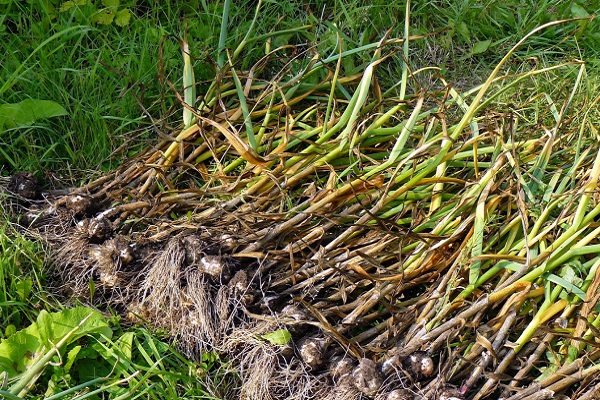
Harvesting products at the time of technological maturity of the grown plants can increase the yield. The harvested vegetable will have a marketable appearance, differ in suitability for sale, consumption, storage and for crops.
If garlic is planted in Siberia in the fall, the optimal time for harvesting it falls on the second half of July.
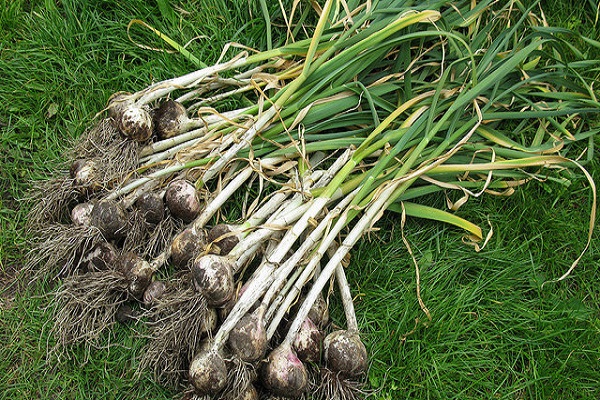
Features of winter garlic
Garlic is an annual bulbous plant that propagates vegetatively - with cloves or airy bulb-seeds (bulbs). It can withstand frosts down to -4 ° C and below. The best varieties of winter garlic for Siberia keep well under the snow, but freeze in cold, snowless winters.
Vegetation begins in April at a temperature of + 5 ... + 10 ° С. During the formation of the heads, the plant needs warmth and sun. The temperature during this period should be at least + 15 ... + 20 ° С, and at the time of ripening - not lower than + 20 ... + 25 ° С.
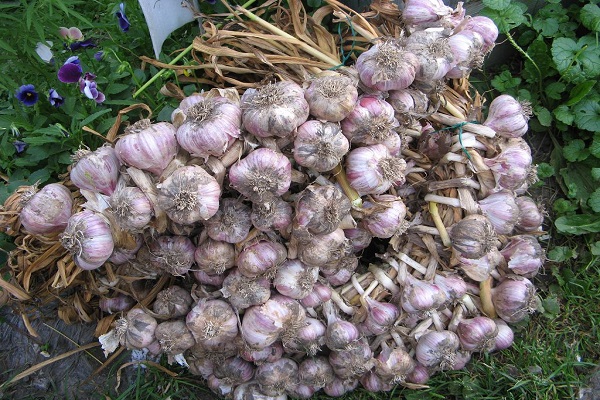
The plant is sensitive to changes in growing conditions, so it is best to use zoned varieties. The best winter varieties for Siberia are the non-shooting Novosibirsk 1 and the Siberian arrow. In addition, the following arrow-yielding varieties for winter plantings are grown: Alkor, SIR-10, Skif, Osenny, Gradekovsky, Bashkirsky. Most of them are early maturing varieties. They are weak, but fruitful.
There are some peculiarities of garlic planting in winter.It is planted after cucumbers, radishes and other early vegetables, legumes, in flat areas protected from the wind. During the germination of cloves, the plant is sensitive to moisture. With insufficient moisture, the heads will be small, and the yield will be small. At the same time, in the lowlands, the plant rots. It does not tolerate shading, so it is planted in open and well-lit areas.
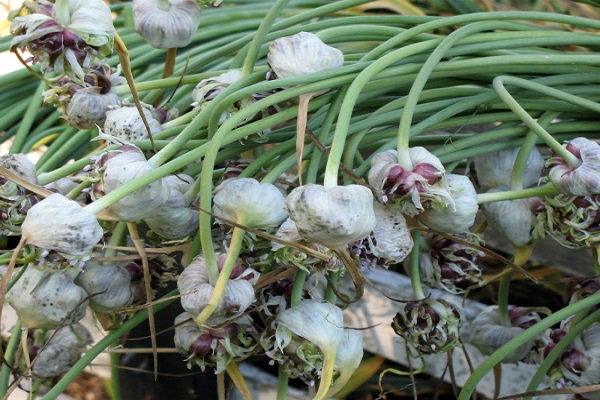
In Siberia, productive varieties for winter plantings are planted from September 15 to October 5, so that the teeth take root before the cold snap, but do not have time to form leaves.
Arrowhead varieties at the end of June throw out arrows, which are removed as they appear, if seeds are not needed. This increases the mass of the heads by 10-15%.
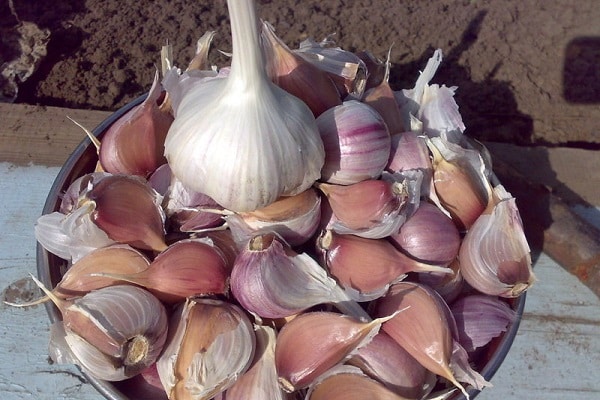
When is garlic harvested in Siberia?
The timing of when to harvest garlic in Siberia depends on the early maturity of the selected varieties. Shooting varieties are dug out after the lower leaves turn 75% yellow, and the film of the inflorescence bolls begins to crack. In these varieties, mature bulbs weigh up to 60 g. Non-shooting varieties are harvested after 2/3 of the leaves of the plant lie on the ground. The non-shooting variety Novosibirsk has mature bulbs weighing up to 35 g.
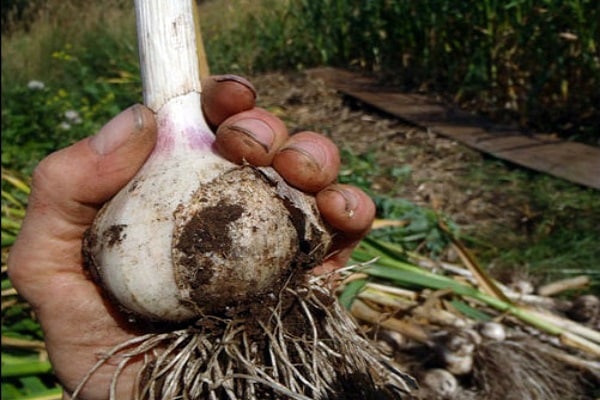
Winter garlic harvest
Determining when to dig out garlic can also be done empirically by freeing several heads from the soil. The cloves in mature bulbs are well separated from each other, and the husks are easily removed. In arrowhead varieties, there are from 4 to 10 cloves in a mature head. They are arranged in one row around the circumference, the weight of such a clove is up to 2 g. In non-shooting varieties, mature heads have up to 30 cloves. They are arranged in a spiral, forming 2-3 circles. The outer teeth are larger and are used for planting.
In Siberia, winter varieties are harvested in the second half of July (25 July + 10 days). At this time, the seed boxes begin to crack. Dry and hot weather speeds up the ripening of the crop. Another sign is that an intensively growing head leads to cracking of the soil.
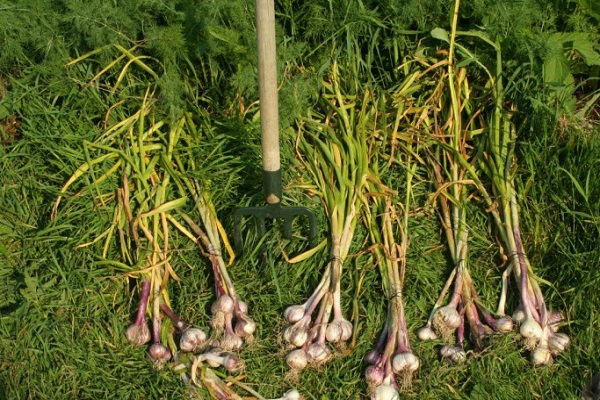
When to dig up spring garlic?
Spring garlic planted in April or May takes longer to ripen than winter garlic, so it is harvested from mid-August until September 10-15. Sometimes harvesting lasts until the end of September, since the growing season of summer varieties ranges from 100 to 125 days. The timing of harvesting is influenced by weather conditions and care during growth. In dry and hot summers, harvesting time shifts to early August.
Correctly determine when to harvest spring garlic, you can in the same way as it is done with winter varieties. Most summer varieties are non-shooting, so foliage is used as a guide to determine when to harvest. You should not wait for full ripening, as rainy weather often falls during the harvest period. To speed up ripening, the bulbs are slightly freed from the soil.

How to clean and store garlic?
If you plan to propagate the plant with cloves, it is harvested at the usual time. If air bulbs are needed for planting next year, several plants with a large arrow and the strongest and healthiest foliage are left in the garden until September. When the arrow head is fully open, dig out the garlic. The next year, large round bulbs will grow from the bulbs. In Altai, the dug out bulbs are sorted and the cloves are used as seed. This is how the used winter varieties are improved.
For the improvement of spring varieties, in Altai, dug out bulbs are sorted, the largest teeth are selected and planted in early June next year or left for the winter.
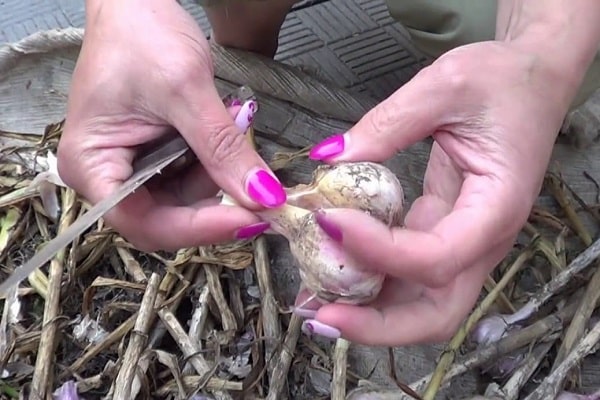
Cleaning times
The timing of harvesting garlic depends on the date of planting, the quality of care, climatic conditions and the growing season of the planted plant variety.
To control the maturation of the arrowhead varieties, arrows are left on several plants. When they are straightened, the garlic can be scooped out.For non-streaked varieties of winter and summer garlic, the readiness indicator is yellowed foliage and a soft neck of the false stem. Good quality bulbs are strong and free from damage.
Cleaning must be done in 1 week.
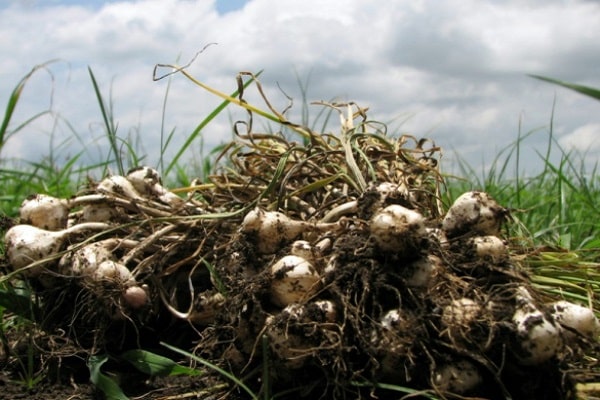
Cleaning technology
Winter garlic is harvested in dry hot weather. Plants stop watering 2-3 weeks before harvesting. Holding them by the tops, they are dug in with a pitchfork, and then gently pulled out. For long-term storage, it is important not to break the integrity of the heads and not damage the shell during digging. Therefore, the earth is carefully removed by hand, without damaging the roots and husks.
This is a culture that does not need to ripen in the sun. The crop must be immediately removed under a canopy along with foliage and roots. Here it is kept for 2-3 weeks. Only then cut at a distance of 2-3 cm from the head or 7-8, if knitting of bundles is planned. The roots are pruned, leaving no more than 2 cm.
The fruits can be washed, but the heads should not touch each other when drying.

Storage
After collection and drying, the heads are sent for storage. There are two ways to do this - warm and cold. For the latter, use a cellar or refrigerator. The temperature at the storage location should not exceed +5 ° С. For the warm method, the bulbs are placed in fabric bags or cardboard boxes. Then they are placed in a dark, cool place: in the pantry, in the attic. The main conditions are the temperature not higher than + 15 ° С and good air exchange.
For planting material, a combination of two storage methods, warm and cold, is permissible. In this case, the heads are kept warm for 6 months, and then they are lowered into the cellar for 2 months or placed in the refrigerator. This method stimulates growth.

Seasonal Tips
The time of planting spring garlic in 2018 is approaching, and the winter vegetable is already in the ground, and the correct choice of the date of collection will affect its safety. The warm and cold seasons of 2018, while promising to be warmer than last year, will nevertheless not be hot enough for a good harvest. At the same time, both the warm and cold seasons promise to be humid, with sufficient rainfall.

Moon calendar
Harvesting of garlic according to the lunar calendar is possible. Often for this, the phase of the waning of the moon is chosen. Given that for full ripening, winter garlic must remain in the garden until mid-July, and spring garlic until mid-August, according to the lunar calendar in 2018, garlic can be harvested:
- In July: 5-7, 15, 16, 19, 20, 23, 24.
- In August: 1-3, 11, 12, 15, 16, 29, 30.
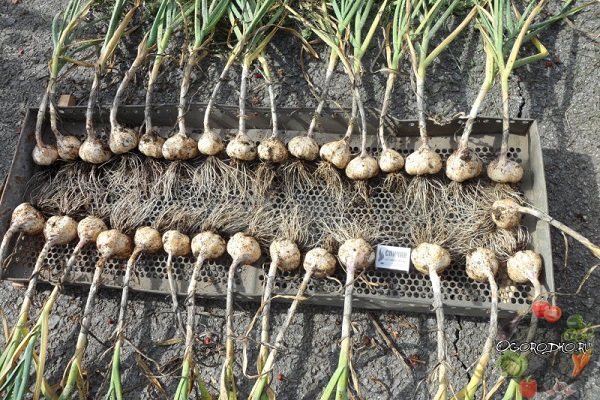
Country life hack
The Siberian region is vast, climatic and agronomic conditions in Eastern and Western Siberia are somewhat different.
In the conditions of Western Siberia, for example, in Novosibirsk, a winter vegetable gives a good harvest. Critical periods are cool May and June. In November, there are snowless frosts, so planting must be completed before October 5. At the same time, there are no winters with little snow.
Apply the following landing pattern. Water the soil abundantly 3 days before planting. On the day of planting, furrows are made up to 20 cm deep, a layer of sand 3 cm thick is poured onto the bottom. Cloves are planted in it. The bulbs are planted to a depth of 25 cm in order to protect them from frost. In spring, garlic is planted in early May, then the harvest time falls in mid-August.
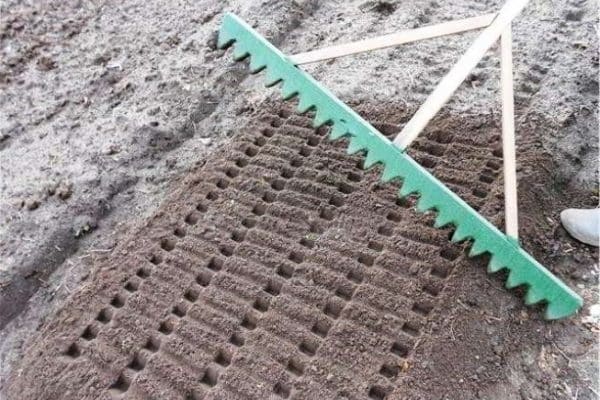
Another life hack is planting garlic in 2 tiers at a depth of 20 and 12 cm, which allows you to get a double harvest. The bulbs are dug up with a pitchfork or flat tines and left in the air for only 10 days, and then carried indoors.
In Irkutsk and other regions of Eastern Siberia, garlic is planted in mid-September - 40 days before the onset of stable cold weather. Winter oats are often sown on top. Due to late spring, harvesting dates are shifted to mid-August. In order to delay ripening for 2-3 weeks and allow the winter garlic bulb to grow a little longer, the leaves are tied in a knot in early July.
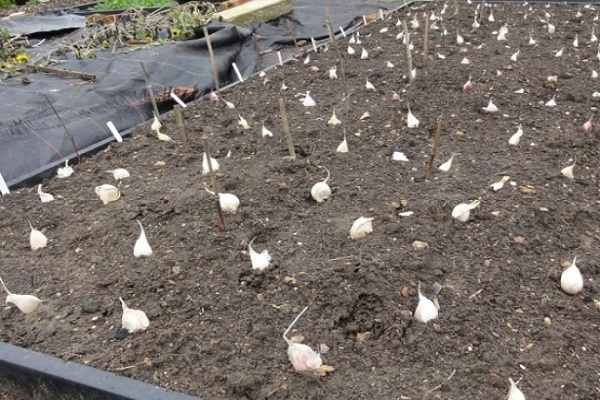
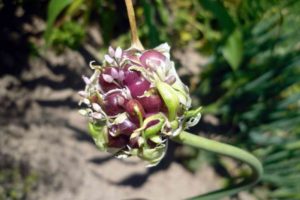
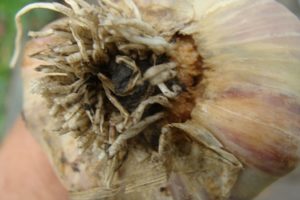
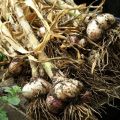

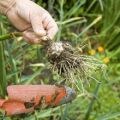
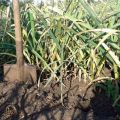
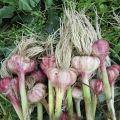
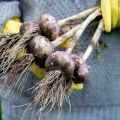

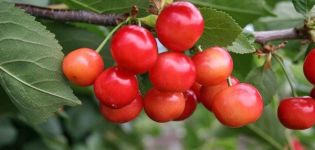
This garlic grows quite large and is easy to peel. When drying, lay it out in one layer, so the heads dry well and do not rot. I love its intense flavor and aroma.